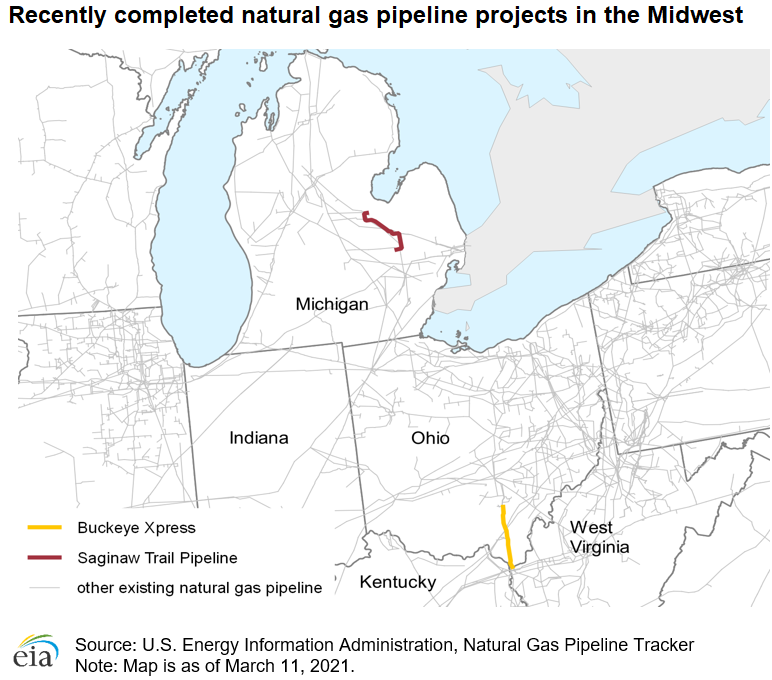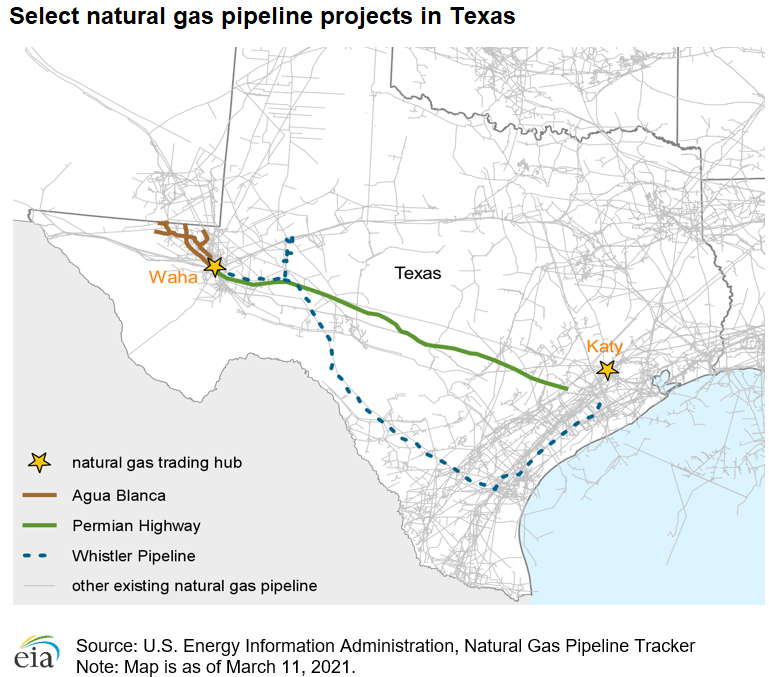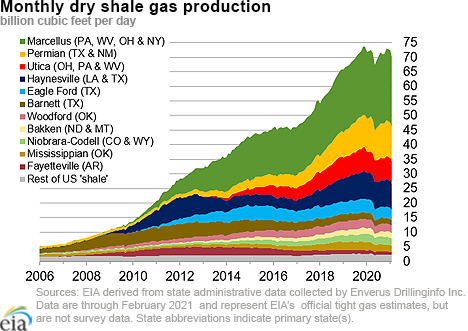In the News:
Recent completions of pipeline projects increase natural gas transportation capacity
From November 2020 through January 2021, approximately 4.4 billion cubic feet per day (Bcf/d) of new natural gas pipeline capacity entered service, according to the U.S. Energy Information Administration’s (EIA) Natural Gas Pipeline Project Tracker.
Four recently completed projects that have increase capacity include:
Saginaw Trail
Consumer Energy’s $610 million intrastate Saginaw Trail Pipeline entered service in late November 2020. This project replaced and expanded natural gas pipelines and infrastructure in Saginaw, Genesee, and Oakland Counties in Michigan, increasing pipeline capacity by 0.2 Bcf/d.
Buckeye XPress
Columbia Gas Transmission’s (CGT) 0.3 Bcf/d Buckeye Xpress Project began operations in December 2020. The $709 million project involved infrastructure improvements and replaced 66 miles of existing natural gas pipeline with a higher-throughput 36-inch pipe in Ohio and West Virginia. The project increases transportation capacity out of the Appalachia Basin into CGT’s interconnection in Leach, Kentucky, and the TCO Pool in West Virginia.
Permian Highway
Kinder Morgan’s Permian Highway Pipeline (PHP) entered service in early January. The 430-mile 42-inch pipeline brings 2.1 Bcf/d of additional natural gas capacity from the Waha Hub, located in West Texas near production activities in the Permian Basin, to Katy, Texas, outside Houston near the Gulf Coast. From Katy the PHP delivered gas will have access to both Gulf Coast and Mexico markets.
Agua Blanca
Whitewater/MPLX’s Agua Blanca Expansion Project, which entered service in late January, connects to nearly 20 natural gas processing sites in the Delaware Basin. It can transport an additional 1.8 Bcf/d of natural gas to the Waha Hub in West Texas. The project will also connect with the Whistler Pipeline, which is scheduled to be completed in the third quarter of 2021 and is expected to move 2.0 Bcf/d of natural gas from the Permian Basin to the Texas Gulf Coast.
In November, Southern Star Central Gas Pipeline completed its Line DT and DS Replacement Project. The project involves replacing 32 miles of pipeline and modifying two existing compressor stations in Anderson and Franklin County, Kansas. The project does not add additional natural gas transportation capacity.
In December, Tellurian withdrew its application to build the Permian Global Access Pipeline in Texas and Louisiana, effectively canceling the project. The proposed 2.0 Bcf/d project would have transported natural gas from the Permian Basin to a proposed liquefied natural gas (LNG) facility in Gillis, Louisiana.
Overview:
(For the week ending Wednesday, March 17, 2021)
- Natural gas spot price movements were mixed this report week (Wednesday, March 10 to Wednesday, March 17). The Henry Hub spot price fell from $2.60 per million British thermal units (MMBtu) last Wednesday to $2.51/MMBtu yesterday.
- At the New York Mercantile Exchange (NYMEX), the price of the April 2021 contract decreased 16¢, from $2.692/MMBtu last Wednesday to $2.528/MMBtu yesterday. The price of the 12-month strip averaging April 2021 through March 2022 futures contracts declined 16¢/MMBtu to $2.734/MMBtu.
- The net withdrawals from working gas totaled 11 Bcf for the week ending March 12. Working natural gas stocks totaled 1,782 Bcf, which is 12% lower than the year-ago level and 5% lower than the five-year (2016–2021) average for this week.
- The natural gas plant liquids composite price at Mont Belvieu, Texas, fell by 7¢/MMBtu, averaging $7.90/MMBtu for the week ending March 17. The prices of propane and butane fell by 2%, continuing declines from the previous week as space heating and gasoline blending seasons come to a close. The price of isobutane remained flat week over week. The price of natural gasoline rose by 1%. The average ethane price rose 1% even as natural gas prices fell, reflecting increased petrochemical feedstock demand for ethane as chemical plants along the Gulf Coast recover from weather-related shut-downs caused by Winter Storm Uri in mid-February.
- According to Baker Hughes, for the week ending Tuesday, March 9, the natural gas rig count remained flat at 92. The number of oil-directed rigs fell by 1 to 309. The total rig count decreased by 1. At 402, the total rig count is now more than 400 for the third week in a row, the highest level since the first week of May 2020 and 158 higher than the 244 level reported in the second week of August 2020, which was the lowest level on record going back to 1987. The rig count remains down year over year at 49% lower than the same week last year.
Prices/Supply/Demand:
Prices in most markets decline week over week along with declining demand. This report week (Wednesday, March 10 to Wednesday, March 17), the Henry Hub spot price fell 9¢ from $2.60/MMBtu last Wednesday to $2.51/MMBtu yesterday after reaching a weekly low of $2.50/MMBtu on Tuesday.
Prices throughout the Midwest decline. Natural Gas Intelligence’s Midwest regional average fell 9¢ from $2.49/MMBtu last Wednesday to $2.40/MMBtu yesterday. At the Chicago Citygate, the price decreased 10¢ from $2.53/MMBtu last Wednesday to $2.43/MMBtu yesterday. Both prices reached a weekly low on Tuesday at $2.37/MMBtu and $2.40/MMBtu, respectively.
Prices in California decline even as temperatures remain significantly lower than normal. Temperatures reported for Los Angeles and San Francisco remained in the low 50’s throughout most of the report week, on average 7°F and 4°F lower than normal, respectively. The price at PG&E Citygate in Northern California fell 7¢, down from $3.67/MMBtu last Wednesday to $3.60/MMBtu yesterday. Prices at the Malin hub at the California/Oregon border fell 34¢, from $2.69/MMBtu last Wednesday to $2.35/MMBtu yesterday. This decline was the largest of all major trading hubs, reflecting price declines at two major natural gas supply sources into the region: Western Canada and the Rockies. The price at Sumas on the Canada-Washington border fell 24¢ from $2.61/MMBtu last Wednesday to $2.37/MMBtu yesterday. The price at Kingsgate, on the Alberta/Idaho border, fell 17¢ from $2.33/MMBtu last Wednesday to $2.16/MMBtu yesterday. The price at the Opal Hub in southwest Wyoming, the origin point for the Ruby Pipeline, fell 25¢ from $2.66/MMBtu last Wednesday to $2.41/MMBtu yesterday. The price at SoCal Citygate in Southern California decreased 19¢ from $3.43/MMBtu last Wednesday to a weekly low of $3.24/MMBtu yesterday as temperatures in the Los Angeles area began to warm compared to early in the report week. Kern River Gas Transmission Company completed previously reported maintenance on its Goodsprings Compressor Station outside of Las Vegas, Nevada, allowing for additional supplies to reach Southern California from the Opal Hub.
Northeast prices rise as temperatures fall lower than normal for this time of year. After averaging higher than average for most of last week (Monday through Sunday), temperatures in New England fell on Monday and remained low Tuesday and Wednesday. At the Algonquin Citygate, which serves Boston-area consumers, the price went up 39¢ from $2.37/MMBtu last Wednesday to $2.76/MMBtu yesterday after reaching a weekly high of $4.52/MMBtu on Monday. At the Transcontinental Pipeline Zone 6 trading point for New York City, the price increased 14¢ from $2.11/MMBtu last Wednesday to $2.25/MMBtu yesterday after reaching a weekly high of $2.38/MMBtu on Friday.
Reflecting higher regional demand, prices in the Appalachia Basin production area increase. The Tennessee Zone 4 Marcellus spot price increased 9¢ from $1.91/MMBtu last Wednesday to $2.00/MMBtu yesterday. The price at Dominion South in Southwest Pennsylvania rose 5¢ from $2.03/MMBtu last Wednesday to $2.08/MMBtu yesterday. Both pricing points reached a weekly high on Friday at $2.09/MMBtu and $2.17/MMBtu, respectively.
Prices in the Permian production region increase slightly. The price at the Waha Hub in West Texas, which is located near Permian Basin production activities, averaged $2.35/MMBtu last Wednesday, 25¢/MMBtu lower than the Henry Hub price. Yesterday, the price at the Waha Hub averaged $2.36/MMBtu, 15¢/MMBtu lower than the Henry Hub price and 1¢/MMBtu higher week on week.
Natural gas production stays relatively flat week over week. According to data from IHS Markit, the average total supply of natural gas fell by 0.3% compared with the previous report week. Dry natural gas production decreased by 0.1% compared with the previous report week. Average net imports from Canada decreased by 4.2% from last week and now account for less than 5% of total supply.
Demand declines as the end of the heating season approaches. Total U.S. consumption of natural gas fell by 3.9% compared with the previous report week, according to data from IHS Markit. Consumption in the residential and commercial sectors declined by 9.0%. Industrial sector consumption decreased by 1.8% week over week. Natural gas consumed for power generation climbed by 0.5% week over week as lower natural gas prices made natural-gas fueled power generation more competitive. Natural gas exports to Mexico decreased 0.4%. Natural gas deliveries to U.S. liquefied natural gas (LNG) export facilities (LNG pipeline receipts) averaged 11.1 Bcf/d, or 0.45 Bcf/d higher than last week. Demand for the week was 0.7% lower than the same week last year.
U.S. LNG exports decrease week over week. Eighteen LNG vessels (seven from Sabine Pass, four from Freeport, three from Cameron, and two each from Corpus Christi and Cove Point) with a combined LNG-carrying capacity of 67 Bcf departed the United States between March 11 and March 17, 2021, according to shipping data provided by Bloomberg Finance, L.P.
Storage:
The net withdrawals from storage totaled 11 Bcf for the week ending March 12, compared with the five-year (2016–2021) average net withdrawals of 59 Bcf and last year's net withdrawals of 15 Bcf during the same week. Working natural gas stocks totaled 1,782 Bcf, which is 93 Bcf lower than the five-year average and 253 Bcf lower than last year at this time.
According to The Desk survey of natural gas analysts, estimates of the weekly net change to working natural gas stocks ranged from net withdrawals of 4 Bcf to 29 Bcf, with a median estimate of 17 Bcf.
The average rate of withdrawals from storage is 16% higher than the five-year average so far in the withdrawal season (November through March). If the rate of withdrawals from storage matched the five-year average of 3.6 Bcf/d for the remainder of the withdrawal season, the total inventory would be 1,713 Bcf on March 31, which is 93 Bcf lower than the five-year average of 1,806 Bcf for that time of year.
More storage data and analysis can be found on the Natural Gas Storage Dashboard and the Weekly Natural Gas Storage Report.
See also:
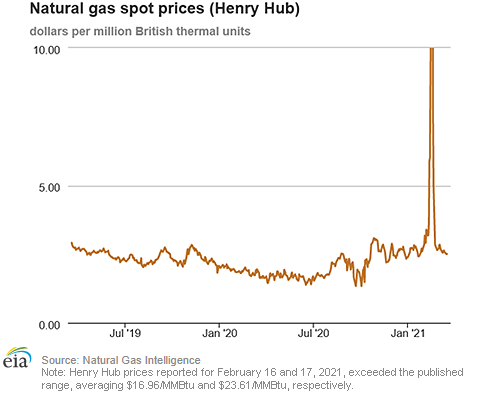
| Spot Prices ($/MMBtu) | Thu, 11-Mar |
Fri, 12-Mar |
Mon, 15-Mar |
Tue, 16-Mar |
Wed, 17-Mar |
|---|---|---|---|---|---|
| Henry Hub |
2.64 |
2.59 |
2.52 |
2.50 |
2.51 |
| New York |
2.07 |
2.38 |
2.35 |
2.25 |
2.25 |
| Chicago |
2.55 |
2.48 |
2.48 |
2.40 |
2.43 |
| Cal. Comp. Avg.* |
3.05 |
2.96 |
2.94 |
2.85 |
2.87 |
| Futures ($/MMBtu) | |||||
| April contract | 2.668 |
2.600 |
2.484 |
2.562 |
2.528 |
| May contract |
2.703 |
2.636 |
2.523 |
2.597 |
2.555 |
| *Avg. of NGI's reported prices for: Malin, PG&E Citygate, and Southern California Border Avg. | |||||
| Source: NGI's Daily Gas Price Index | |||||
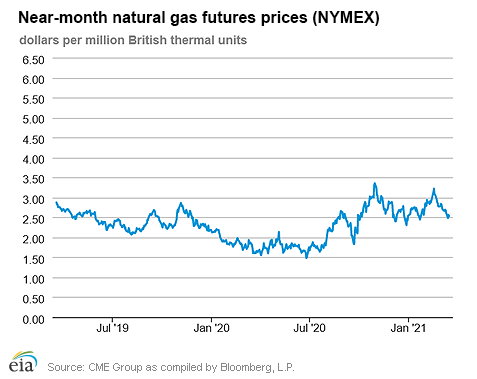
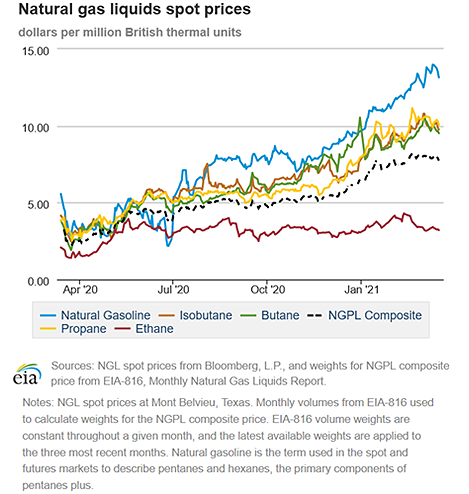
| U.S. natural gas supply - Gas Week: (3/11/21 - 3/17/21) | |||
|---|---|---|---|
Average daily values (Bcf/d): |
|||
this week |
last week |
last year |
|
| Marketed production | 102.7 |
102.8 |
106.6 |
| Dry production | 90.8 |
90.9 |
93.6 |
| Net Canada imports | 4.6 |
4.8 |
4.0 |
| LNG pipeline deliveries | 0.1 |
0.1 |
0.1 |
| Total supply | 95.4 |
95.7 |
97.7 |
|
Source: IHS Markit | |||
| U.S. natural gas consumption - Gas Week: (3/11/21 - 3/17/21) | |||
|---|---|---|---|
Average daily values (Bcf/d): |
|||
this week |
last week |
last year |
|
| U.S. consumption | 77.0 |
80.1 |
80.4 |
| Power | 25.1 |
24.9 |
28.8 |
| Industrial | 23.6 |
24.0 |
23.4 |
| Residential/commercial | 28.4 |
31.2 |
28.2 |
| Mexico exports | 5.6 |
5.6 |
5.4 |
| Pipeline fuel use/losses | 6.5 |
6.6 |
6.9 |
| LNG pipeline receipts | 11.1 |
10.6 |
8.3 |
| Total demand | 100.2 |
103.0 |
101.0 |
|
Source: IHS Markit | |||
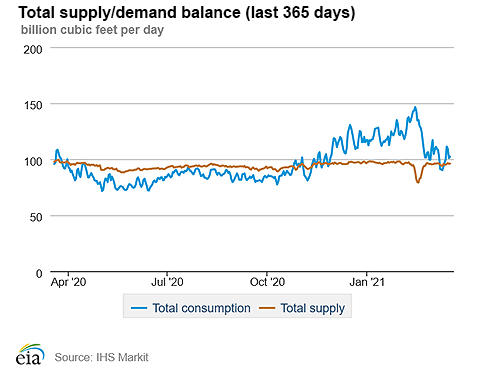
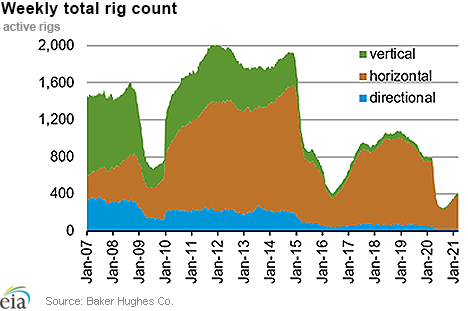
| Rigs | |||
|---|---|---|---|
Tue, March 09, 2021 |
Change from |
||
last week |
last year |
||
| Oil rigs | 309 |
-0.3% |
-54.8% |
| Natural gas rigs | 92 |
0.0% |
-14.0% |
| Note: Excludes any miscellaneous rigs | |||
| Rig numbers by type | |||
|---|---|---|---|
Tue, March 09, 2021 |
Change from |
||
last week |
last year |
||
| Vertical | 25 |
0.0% |
-19.4% |
| Horizontal | 362 |
0.0% |
-49.2% |
| Directional | 15 |
-6.3% |
-68.8% |
| Source: Baker Hughes Co. | |||
| Working gas in underground storage | ||||
|---|---|---|---|---|
Stocks billion cubic feet (Bcf) |
||||
| Region | 2021-03-12 |
2021-03-05 |
change |
|
| East | 328 |
350 |
-22 |
|
| Midwest | 426 |
440 |
-14 |
|
| Mountain | 114 |
113 |
1 |
|
| Pacific | 199 |
205 |
-6 |
|
| South Central | 715 |
685 |
30 |
|
| Total | 1,782 |
1,793 |
-11 |
|
|
Source: Form EIA-912, Weekly Underground Natural Gas Storage Report | ||||
| Working gas in underground storage | |||||
|---|---|---|---|---|---|
Historical comparisons |
|||||
Year ago (3/12/20) |
5-year average (2016-2020) |
||||
| Region | Stocks (Bcf) |
% change |
Stocks (Bcf) |
% change |
|
| East | 414 |
-20.8 |
353 |
-7.1 |
|
| Midwest | 514 |
-17.1 |
449 |
-5.1 |
|
| Mountain | 96 |
18.8 |
107 |
6.5 |
|
| Pacific | 199 |
0.0 |
186 |
7.0 |
|
| South Central | 811 |
-11.8 |
779 |
-8.2 |
|
| Total | 2,035 |
-12.4 |
1,875 |
-5.0 |
|
| Source: Form EIA-912, Weekly Underground Natural Gas Storage Report | |||||
| Temperature – heating & cooling degree days (week ending Mar 11) | ||||||||
|---|---|---|---|---|---|---|---|---|
HDD deviation from: |
CDD deviation from: |
|||||||
| Region | HDD Current |
normal |
last year |
CDD Current |
normal |
last year |
||
| New England | 218 |
0 |
66 |
0 |
0 |
0 |
||
| Middle Atlantic | 195 |
-9 |
49 |
0 |
0 |
0 |
||
| E N Central | 154 |
-63 |
-12 |
0 |
-1 |
0 |
||
| W N Central | 127 |
-89 |
-39 |
0 |
-1 |
0 |
||
| South Atlantic | 122 |
-3 |
19 |
6 |
-4 |
-6 |
||
| E S Central | 102 |
-16 |
6 |
0 |
-4 |
0 |
||
| W S Central | 51 |
-22 |
-3 |
11 |
2 |
2 |
||
| Mountain | 144 |
-25 |
10 |
2 |
1 |
1 |
||
| Pacific | 125 |
32 |
36 |
0 |
-1 |
0 |
||
| United States | 138 |
-23 |
12 |
3 |
0 |
-1 |
||
|
Note: HDD = heating degree day; CDD = cooling degree day Source: National Oceanic and Atmospheric Administration | ||||||||
Average temperature (°F)
7-day mean ending Mar 11, 2021
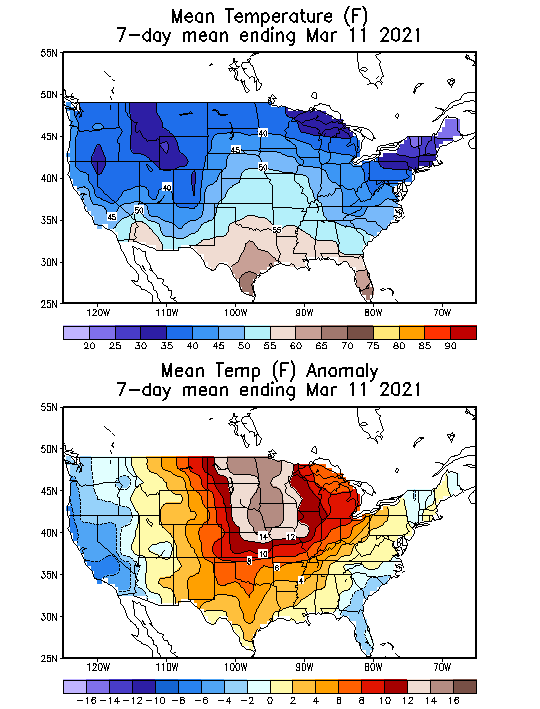
Source: National Oceanic and Atmospheric Administration
Deviation between average and normal (°F)
7-day mean ending Mar 11, 2021

Source: National Oceanic and Atmospheric Administration

